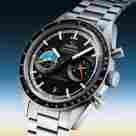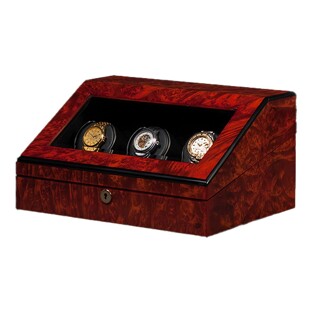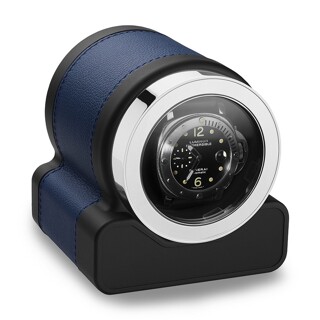Watch Winders
About Watch Winders
What is a Watch Winder?
A Watch Winder is a device that keeps an automatic or self-winding watch’s mainspring wound and the watch running when it is not being worn. It simulates the natural movement of your hands by rotating your timepiece multiple times through the aid of a programmed rotor.
The watch winder serves the alternate purpose of a storage box or display unit, a place where you can store your watches while they are not in use.How does a watch winder work?
Watch winders keep your kinetic movement watch ticking when it's not being worn. Depending on which model you choose, you can set the winder to a clockwise, counterclockwise, or alternate rotation. Also, you can set up how many revolutions you want per day. The typical winders allow you to choose from 300 revolutions to as many as 2,000 revolutions. The more luxe winders also include a timer/resting feature that cycles your watch off and on rotations to prevent wear and tear.
Watch winders only work for watches with kinetic movements. Quartz watches that run on batteries don't benefit from the rotation and maintenance functions that winders offer.
How was the watch winder invented?
An English Watchmaker by the name of John Harwood invented the first watch winder in 1922. His invention was a solution to the first self-winding watch invented back in 1776 by Abram Louys Perrelet.
Inspired by children playing on the seesaw, John realized that he could harness kinetic energy to power watches. With his design, stored kinetic energy accumulated in the watch's spring will gradually be released to power the watch's hands.
In 1924, Harwood received a patent for pioneering the self-winding wristwatch. After two years of development, the watch operated on an oscillating weight that moved through an arc of 270 degrees.
In 1931, Rolex, the luxury timepiece brand, entered the automatic watch market by introducing their rotor movement technology capable of a 360-degree wind. Their newly introduced line of watches, the Rolex Oyster Perpetuals, ran on that very same technology. It wound through a complete 360-degree rotation.
Rolex's introduction of their rotor movement sparked controversy between the company and Harwood Self-Winding Watch Co. This controversy was eventually put to bed in 1956 when Rolex apologized and offered John Harwood full credit for his invention of the world's first automatic wristwatch.
The first watch winder was invented shortly after John Harwood began marketing his first commercial automatic wristwatches. They functioned as a sort of guarantee device that demonstrated how the kinetic energy storage system worked.
The first-ever watch winder was a 12 watch winder. As more and more self-winding watches became more popular, store owners adopted the watch winder to confirm the authenticity of the watches they offer. It's been over 80 years since the first watch winders found their way to jewelry stores, and they have become even more popular since then. Now, watch owners and enthusiasts keep them on hand to help them keep their devices wound and working.
Do You Need a Watch Winder?
If you have a timepiece that runs on a kinetic movement, then yes, you do. Kinetic movement timepieces run on energy build up in the hairspring of the watch during movement. When your watch is stationary, that energy runs low. A watch winder will keep your watches wound and full of energy whenever you decide to use them.
They also serve a maintenance function that prevents the lubricants inside that reduces the friction between your watch mechanical parts from drying up or coagulating. This indirectly reduces the number of lubricant changes and maintenance you need to perform in the long term.
They also save you the hassle of resetting and rewinding. Depending on how much energy you have in your watch, it will last somewhere between a few days or weeks after winding. After your watch stops, you'll have to manually wind it and reset the date and time whenever you plan to wear it. Having a watch winder can help you avoid the hassle of taking time out of your day to complete that tedious task.
Different Types of Watch Winders
Watch winders are classified according to specification and functionality. Unlike luxury watches, they operate on very basic principles and don't have too many moving parts.
There are two types of watch winders, unidirectional winders, and alternate directional winders.
Unidirectional Watch Winders
Unidirectional winders rotate in one direction only, either clockwise or anticlockwise. While these types of winders technically wind your watches just as well as alternate direction winders, they don't distribute the wear. Your watch's hairspring and movement wear out with time and movement. Since winders simulate movement and consequently causes wear, it would be better for your watch in the long term if that wear was distributed equally on both sides.
Alternate Directional Watch Winders
Alternate directional winders alternate between clockwise and anticlockwise rotations while they wind. They are the more expensive of the two winder options and have a timer and counter to track each side's rotation. They distribute the rotation wear that winders cause more evenly.
Most luxury watch winders provide alternative directional winders. Swiss Kubik, Orbit Watch, Underwood, Scatola Del Tempo are great examples of this. They pair the most mesmerizing custom-made exterior finishes with patented motion technology to simulate the best natural watch winding rotations.
Aside from these two major types of winders, we also have the battery and electric run winders, single and multi-watch winders, and finally, luxury and utilitarian winders.
Final Thoughts
Watch winders come in all shapes and sizes but perform similarly for the most part. Their prices range from somewhere between USD 100 to over USD 1,000. More expensive watch winder brands or types usually offer more watch holders, have precise rotation controls, and superior exterior aesthetics. Lower priced winders are very utilitarian and often feature the bare minimum. If you are in the market for a great winder, check out our unique selection at Exquisite Timepieces.






